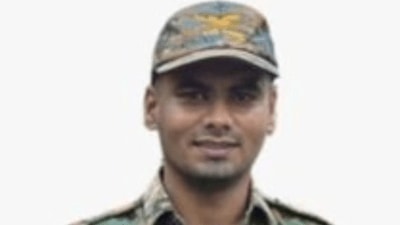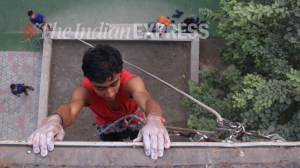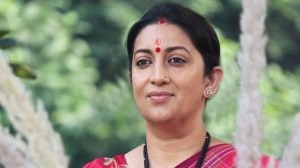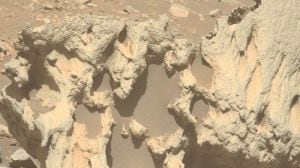Want reality? Visit Wataman Chowky
An Indian novelist who won an international prize wrote an article on the Narmada. Two editors, each claiming exclusive'' rights, publi...

An Indian novelist who won an international prize wrote an article on the Narmada. Two editors, each claiming “exclusive” rights, published it the same week. It was reportedly based on a “field visit”, having lived and worked in that area. Since “facts” were obviously coming from a briefing to an eco-tourist and the photos were tiring replicas, I should have left the article alone. But the law of generational progress is an article of faith with me for the younger ones have to be smarter than us. This one said that those who had planned Sardar Sarovar had gone away.
This of course is not true, I have planned Sardar Sarovar on a one rupee a month salary and am still living in the command. I involved every university and research institute in Gujarat in making the plan, and at least one college in every taluka to do benchmark studies and these “young rubbed shoulders with some of the best experts, who also were hired, to fashion” an agricultural and rural development plan” which was a great steptowards in integrating water management technology to the needs of small farms. All of us from Gujarat are still there but the critics wouldn’t know since they never come to Gujarat. The India International Center is decidedly more comfortable.
Anyway, as the novelist would say, how boring. A matter of detail, it is said that things have changed in villages in Gujarat and the water will go to the cities only. My life’s savings are in a small house in the rural part of Ahmedabad and it is only about 70 km from the most difficult area to be irrigated by the Narmada. So I got into a jeep and set off for the Bahl at the gulf of Khambhat at Dholera.
The Bahl is a very difficult region. It is the low lying area between the rest of Gujarat and Saurashtra. It is a bowl, and the waters of the monsoon flow into it from all sides. Now water is a terrible problem here. There is a lot of it and after it drains out there is none and it is all of bad quality. My friend the Gandhian Ambubhai Shah has spent a lifetime atGundi, Lothal, to water harvest. We help the Bahl Nalakantha Pryojak Sangh, but it is basically a difficult area.
In places take the Bahl, there is no usable water in many parts of the year. The Gandhians in Gujarat and some others like Anil Patel of the Arch Vahini who fought for the adivasis and now really help rehabilitate them, have no need to abuse Nehru Chacha or dams the way our young writer and her foreign sponsored “Independent Review” do. The Gandhians were with the adivasi during the Independence movement and know that the British hanged them and so, like the pseudo-environmentalists of the Independent Review and some others, they don’t say that as a part of the freedom movement the adivasis were converted into Hindus by the nationalists. As the social anthropologist Chris Degan has shown, these fanatics, like some other more recent ones, have no idea of the non-Brahmanical strands of religion in which the adivasi, the scheduled caste, the worker and the farmer revel. The Independent Review andits friends have no place for Kabir, Rahim Guru Baba Nanak and the Shirdi Sai for that way you don’t get international prizes.
Now we are really descending into the Gulf area, the fifteen-foot contour below which nothing will grow. The Swede, Per Jung, was both an economist and engineer and a man of great sensitivity, trained by Myrdal. He would tell me: no irrigation in the Bahl and so no Saurashtra Branch. I showed him how the farmer made very careful use of water and a little more would have great value and solve great misery. We would deliver it in controlled conditions and drain it. Meanwhile, we would continue work on better answers for the growth of the area. After a lot of work we agreed that the fifteen-foot contour above the sea level would be our dividing line. I was in this trip still above this line and so Narmada waters would come here.
We stop by at Wataman, an average size village in the region. Kalubhai Bharwad is the Sarpanch. He tells me that in the Chaumasa (the monsoon) the Sabarmati,which is now entering the phase of reaching the marshes of Khambhat, floods the village. He asks me whether I can find money for a concrete village road. Who will maintain it? He says they will collect a fixed deposit of Rs 5,000 (the operation and maintenance charge of a five-lakh rupee road) and I promise to get him the money to build the road. How was the wheat crop? We grew Dangar, he says. I can’t believe my ears. You grew rice? Yes, he says matter of factly. How? I ask him, knowing that water supply for paddy in the kharif is just not there. There is water, which came, down the industrial effluent channel, he says. We pump it, filter it, and use it. I still can’t believe it. Let my people live. Let us get that 19 inches of fresh water. You say we can’t deliver it efficiently — but we have already done so in a pilot in channels where the Narmada system is in place. The efficiency is 60 percent. And now Kalu Bharwad, Sarpanch of the Wataman Chowky and his friends on the road to Dholera are a livinganswer to all the drawing room skeptics back in Delhi. I talk this over with the Indian Jesuit priest of Spanish birth, Father Franco, a legend with generations of students at Ahmedabad. He has worked in the area. He laughs and says, they can do it at the Wataman Chowky. If you believe in sustainable development, show up at the Wataman Chowky.




- 01
- 02
- 03
- 04
- 05



























